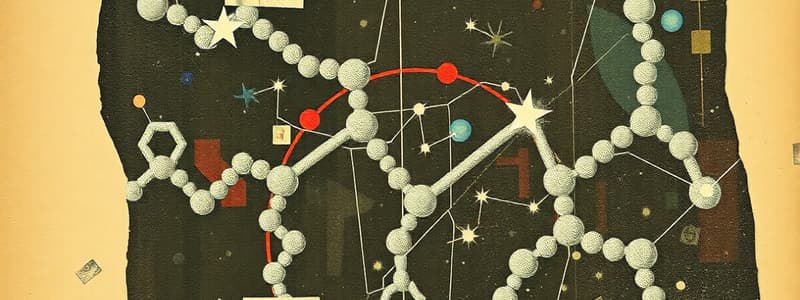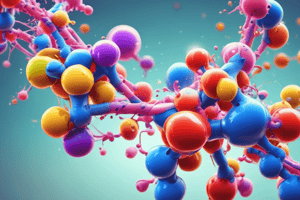Podcast
Questions and Answers
Which of the following is the term for the process that removes water to join monomers, forming polypeptides, oligopeptides, or dipeptides?
Which of the following is the term for the process that removes water to join monomers, forming polypeptides, oligopeptides, or dipeptides?
- Translation
- Hydrolysis
- Dehydration synthesis (correct)
- Replication
If a protein is found to be non-functional due to a significant change in its environment, such as extreme pH or temperature, which level of protein structure is most likely to be initially affected?
If a protein is found to be non-functional due to a significant change in its environment, such as extreme pH or temperature, which level of protein structure is most likely to be initially affected?
- Tertiary (correct)
- The change would impact all levels equally
- Secondary
- Primary
What characteristic defines amino acids as either hydrophobic or hydrophilic?
What characteristic defines amino acids as either hydrophobic or hydrophilic?
- The number of peptide bonds they form.
- The properties of their R-side group. (correct)
- The presence or absence of a central carbon atom.
- Their reaction to changes in pH.
If the optimal pH for pepsin is 1.5 and the optimal pH for salivary amylase is 6.3, how would placing both enzymes in a solution with a pH of 9 affect their function?
If the optimal pH for pepsin is 1.5 and the optimal pH for salivary amylase is 6.3, how would placing both enzymes in a solution with a pH of 9 affect their function?
Enzymes increase the rate of reactions by:
Enzymes increase the rate of reactions by:
Which type of bond is directly responsible for the primary structure of a protein?
Which type of bond is directly responsible for the primary structure of a protein?
What kind of bonds are disrupted by changes in pH or temperature?
What kind of bonds are disrupted by changes in pH or temperature?
Given the optimal temperatures for Pectinase, Xylanase, and Cellulase are all around 45-51°C, what affect would a prolonged winter and average temperature of 15°C have?
Given the optimal temperatures for Pectinase, Xylanase, and Cellulase are all around 45-51°C, what affect would a prolonged winter and average temperature of 15°C have?
If a disease prevents disulfide bridges from forming correctly, which level of protein structure would be most directly affected?
If a disease prevents disulfide bridges from forming correctly, which level of protein structure would be most directly affected?
If two amino acids are joined together, what is the resulting molecule called?
If two amino acids are joined together, what is the resulting molecule called?
Flashcards
Amino acid
Amino acid
The smallest unit of a protein.
Peptide bond
Peptide bond
A bond that connects two amino acids together.
Oligo-peptide
Oligo-peptide
A chain of 3-10 amino acids.
Polypeptide
Polypeptide
Signup and view all the flashcards
Hydrophobic amino acids
Hydrophobic amino acids
Signup and view all the flashcards
Hydrophilic amino acids
Hydrophilic amino acids
Signup and view all the flashcards
Dehydration synthesis
Dehydration synthesis
Signup and view all the flashcards
Catalyst
Catalyst
Signup and view all the flashcards
Active site
Active site
Signup and view all the flashcards
Low temperature
Low temperature
Signup and view all the flashcards
Study Notes
- The shape of a molecule determines its role in cellular processes like metabolism, homeostasis, growth, development, and heredity.
- Most cellular processes involve proteins acting as enzymes.
Proteins
- The smallest unit of a protein is called an amino acid.
- There are four parts to an amino acid bonded to a central carbon:
- amine group
- R-side group
- Carboxyl group
- Hydrogen
Protein Functions
- Proteins are used for making other proteins, which make up enzymes
- Proteins are used for several biological functions
- Proteins transmit and express hereditary features.
Peptide bonds
- Two amino acids together are connected by a peptide bond, forming a dipeptide.
- 3-10 amino acids together form oligo-peptides.
- More than 10 amino acids together form polypeptides.
Amino acids
- Hydrophobic amino acids are nonpolar and repel water.
- Hydrophilic amino acids are polar and interact with water.
Dehydration synthesis
- Dehydration synthesis / condensation reaction is the process that removes water to create polypeptides/oligopeptides/dipeptides.
- Proteins are made of carbon, hydrogen, oxygen, nitrogen, and sulfur.
Types of Bonds Review
- Peptide bonds are covalent and strong, characterized by water removal from amine and carboxyl groups.
- Hydrogen bonds are weak and characterized by hydroxyl groups.
- Disulfide bonds are covalent and strong, characterized by two cysteines (S-S).
- Salt bridges are ionic and medium in strength, characterized by positive and negative amino acid attractions.
Protein Structure
- Primary structures are straight-chain, disrupted by peptide bonds, pH, and temperature
- Secondary structures are alpha helix/beta sheets, bonded by H-bonds, disrupted by ethanol/polar solvents.
- Tertiary structures are globular with full function, disulfide, salt bridges, disrupted by pH and temperature.
- Quaternary structures are globular, with many tertiary structures, bonded by H-bonds, disrupted by ethanol/polar solvents.
Enzymes
- Enzymes are catalysts, which speed up biological processes.
- In an enzyme diagram:
- The substrate binds slightly as the enzyme changes shape
- The active site is where the substrate binds
- The enzyme is the catalyst
- When relating potential energy to a diagram
- Products come after reactants
- Activation energy without the enzyme is higher than with the enzyme
Additional notes from work sheets
- The likely optimal temperature for Pectinase is 49-51°C
- The likely optimal temperature for Xylanase is 49-51°C
- The likely optimal temperature for Cellulase is 46-47°C
- The optimal pH for pepsin is 1.5.
- The optimal pH for salivary amylase is 6.3.
- The optimal pH for alkaline phosphatase is 9.
Studying That Suits You
Use AI to generate personalized quizzes and flashcards to suit your learning preferences.




